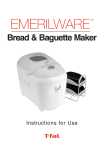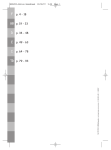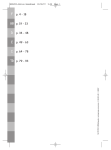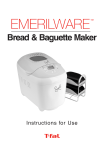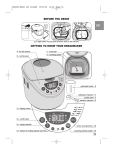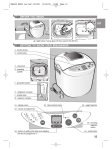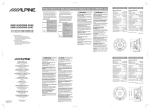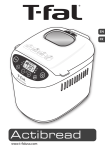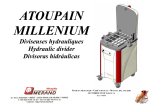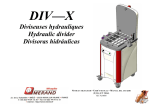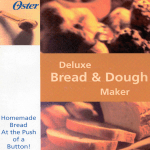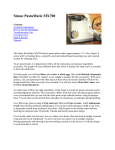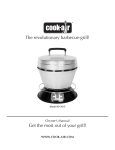Download Moulinex Bread Maker Operating instructions
Transcript
MOULF35-Notice HomeBread 30/08/07 9:08 Page 3 F GB 1 4a 2 4b 4d 4e 4c D 4f E 4g 3 4 I TR 5 6 7 10 8a 9 8b 11 MOULF35-Notice HomeBread 30/08/07 9:08 Page 4 fig.2 fig.1 fig.4 fig.3 Po c a c e 1 fig.5 • fig.7 fig.6 fig.8 1 2 • fig.10 fig.9 fig.12 fig.11 • • • fig.14 fig.13 fig.16 fig.15 • fig.17 fig.19 fig.18 fig.20 • • • • fig.22 fig.21 1 fig.24 fig.23 2 55MN • 2cm 1cm 4 MOULF35-Notice HomeBread 30/08/07 9:08 Page 19 F SAFETY RECOMMENDATIONS ploi otre e au de For your safety, this appliance conforms with applicable standards and regulations (Directives on low voltage, electromagnetic compatibility, materials in contact with foodstuffs, environment, etc.) 1. CONDITIONS de eux cte OF USE • This appliance is not intended to be operated using an external timer or separate remote control system. • This appliance is not designed to be used by people (including children) with a physical, sensory or mental impairment, or people without knowledge or experience, unless they are supervised or given prior instructions concerning the use of the appliance by someone responsible for their safety. • Children must be supervised to ensure that they do not play with the appliance. • Your appliance is designed for indoor home use only. • Unplug the appliance when you have finished using it and when you clean it. • Do not use the appliance if: - the supply cord is defective or damaged, - the appliance has fallen to the floor and shows visible signs of damage or does not function correctly. In either case, the appliance must be sent to the nearest approved service centre to eliminate any risk. See the guarantee documents. • All interventions other than cleaning and everyday maintenance by the customer must be performed by an authorised service centre. • Do not immerse the appliance, power cord or plug in water or any other liquid. • Do not leave the power cord hanging within reach of children. • The power cord must never be close to or in contact with the hot parts of your appliance, near a source of heat or over a sharp corner. • Do not use the appliance if the power cord or plug is damaged. The power cord must be replaced by an authorised service centre to avoid any danger (see the list in the service booklet). • Do not touch the viewing window during and just after operation. The window can reach a high temperature. • Do not place the appliance on other appliances. • Do not use the appliance as a source of heating. • Do not place paper, card or plastic in the appliance and place nothing on it. • Should any part of the appliance catch fire, do not attempt to extinguish it with water. Unplug the appliance. Smother flames with a damp cloth. • For your safety, only use accessories and spare parts designed for your appliance. • All appliances undergo strict quality control. Practical usage tests are performed on randomly selected appliances, which would explain any slight traces of use. • The knife supplied has a very sharp blade. Please ensure the sheath is put on again after use and that the knife is put away in a safe place. • At the end of the programme, always use oven gloves to handle the pan or hot parts of the appliance. The appliance and baguette accessory become very hot during use. • Never obstruct the air vents. • Be very careful, steam can be released when you open the lid at the end of or during the programme. • When using programme No. 11 (jam, compotes) watch out for steam and hot spattering when opening the lid. • Caution, if the dough overflows the baking cavity and touches the heating element, it can catch fire, therefore: - do not exceed the quantities indicated in the recipes - do not exceed 1500 g of dough in total for the bread pan and 450 g of dough in total for baguettes. - do not exceed 280 g of flour and 1 teaspoon of yeast for baguette recipes. - do not exceed 900 g of flour and 5 teaspoons of yeast for recipes in the bread pan. • The measured noise level of this product is 55 dBA. 19 GB D E I TR MOULF35-Notice HomeBread 2. ELECTRICAL 30/08/07 9:08 Page 20 POWER SUPPLY • Make sure that the power it uses corresponds to your electrical supply system. Any error in connection will cancel the guarantee. • You appliance must be plugged into an earthed socket. If this is not the case, an electric shock may be received, possibly causing serious lesions. For your safety, earthing must correspond to the electrical system standards applicable in your country. • Do not pull on the supply cord to unplug the appliance. • Only use an extension lead which is in good condition and which has an earth plug, and ensure that the lead wire has a cross section at least equal to that supplied with the product. 3. REPAIRS Repairs should only be carried out by specialists using original replacement parts. It is dangerous to try to repair an appliance yourself. 1. B •L h to •F 2. A •P th o •M w 3. S •P f DESCRIPTION 1. 2. 3. 4. Bread pan Kneading paddles Lid with window Control panel a. Display screen a1. Weight indicator a2. Crust colour a3. Menu selection a4. Delay start a5. Warming a6. End of baking cycle a7. Timer display b. Choice of programmes c. Weight selection d. On/off button e. Operating indicator light f. Select crust colour g. Buttons for setting delayed start and adjusting the time for programme 14 5. Baguette baking rack 6. 2 non-stick baguette baking trays 7. 8. 9. 10. 11. p e b •C Accessories: Graduated beaker a. Tablespoon measure b. Teaspoon measure Hook for lifting out kneading paddles Brush Slitter f 1 g 4. Y ( •T s f a1 a2 a3 ts tb a4 a5 a6 a7 BEFORE USING FOR THE FIRST TIME 1. REMOVE 20 PACKAGING • Take your appliance out of its packaging. Keep your warranty card and carefully read the operating instructions before using your appliance for the first time - fig. 1. • Install your appliance on a stable surface. Remove all accessories from the appliance (measuring cup, slitter, etc.) fig. 1. Bro We Tim Ing Oil Wa Sal Sug Pow Wh Yea 2. CLEANING THE PAN • Clean the pan of the appliance with a damp cloth. Dry thoroughly - fig. 2. A slight odour may be given off when used for the first time. 3. USING YOUR APPLIANCE FOR THE FIRST TIME • Unroll the power cord and connect it to an earthed socket - fig. 3. • To 3 •T p in c d f MOULF35-Notice HomeBread s in arth as a hat by arts. nce 30/08/07 9:08 F USING 1. BEFORE YOU USE YOUR HOME BREAD BAGUETTE • Lift out the bread trough by lifting the handle and pulling forwards and backwards to unclip the two sides, one by one - fig. 4. • Fit the kneading paddles - fig. 5. 2. ADD THE INGREDIENTS • Put the ingredients in the pan in exactly the order recommended (see useful tips on page 29) - fig. 6. • Make sure that all ingredients are weighed with precision. 3. STARTING UP • Place the bread pan in the breadmaker fig. 7. Replace the bread trough and press on one side then the other to engage the mixer drives and clip it in on both sides - fig. 8. • Close the lid. Plug in the bread maker fig. 3. After you hear the beep, programme 1 settings are displayed by default, i.e. 1000 g, medium browning - fig. 9. 4. YOUR 1 ST RECIPE: BASIC BREAD (programme ) • To get to know your breadmaker, we suggest trying the BASIC BREAD recipe for your first loaf. tsp > Teaspoon tbsp > Tablespoon a4 a5 a6 a7 h a hen TIME o an Page 21 Browning Weight Time > Medium > 1000 g > 3 : 20 Ingredients: Oil Water Salt Sugar Powdered milk White bread flour Yeast > > > > > > > 2 tbsp 325 ml 2 tsp 2 tbsp 2,5 tbsp 600 g 1,5 tsp • To start your recipe, refer to stages 1, 2 and 3 above. • Then, start the BASIC BREAD programme by pressing the button - fig. 10. The indicator light will come on. The timer colon flashes and the timer will count down. The operating indicator lights up fig. 13. The cycle will start. • At the end of the cycle, refer to step 11 below. GB 5. SELECTING THE OTHER PROGRAMMES • A default setting is displayed for each programme - fig. 9. You will therefore have to select the desired settings manually. • Choosing a programme triggers a series of steps which are carried out automatically one after another. • Press the “menu” button to choose from a variety of different programmes. To scroll through programmes 1 to 14, successively press the “menu” button - fig. 10. • The time corresponding to the programme selected is automatically displayed. D E I TR 6. SELECTING THE BREAD WEIGHT • The bread weight is set by default at 1000 g. This weight is shown for informational purposes. Certain recipes cannot be used to make a 750-g loaf. Refer to the recipe book. • Refer to the recipe details for more information. • Programmes 5, 9, 11, 12, 13, 14 do not have weight settings. • Press the button to set the chosen product – 750 g, 1000 g or 1500 g - fig. 11. The indicator light against the selected setting comes on. 7. SELECTING THE CRUST COLOUR • The crust colour is set to medium by default. • Programmes 5, 11, 12 and 13 have no crust colour setting. Three choices are possible: LIGHT/MEDIUM/DARK. • If you want to change the default setting, press the button until the indicator light facing the desired setting comes on fig. 12. 8. STARTING A PROGRAMME • To start the selected programme, press the - fig. 10. The programme starts button up. The time corresponding to the programme is displayed. The successive stages take place automatically, one after the other. 21 MOULF35-Notice HomeBread 30/08/07 9:08 Page 22 9. USING THE DELAY START PROGRAMME • You can programme the appliance up to start 15 hours in advance to have your preparation ready at the time you want. This function cannot be used on programmes 5, 6, 10, 11, 12, 13, 14. This step comes after selecting the programme, browning level and weight. The programme time is displayed. Calculate the time difference between the moment when you start the programme and the time at which you want your preparation to be ready. The machine automatically includes the duration of the programme cycles. Using the and buttons, display the calculated time ( up and down). Short presses change the time by intervals of 10 min + a short beep. Holding the button down gives continuous scrolling of 10-min intervals. For example, it is 8 pm and you want your bread to be ready for 7 am the next morning. Programme 11:00 using the and buttons. Press the button. A beep is emitted. The facing indicator light switches on and the timer colon blinks. The countdown begins. The ON light switches on. If you make a mistake or want to change the time setting, hold down the button until it makes a beep. The default time is displayed. Start the operation again. With the delayed start programme do not use recipes which contain fresh milk, eggs, soured cream, yoghurt, cheese or fresh fruit as they could spoil or stale overnight. 10. STOPPING A PROGRAMME • At the end of the cycle, the programme stops automatically and the indicator comes on next to it . • To stop the programme underway or cancel the delayed start, press and hold the button 5 sec - fig. 10. 11. TAKING YOUR BREAD OUT OF THE PAN • This stage is not applicable to the baguette cycle. Unplug the breadmaker at the end of the cooking or warming cycle - fig. 14. Lift the bread pan out of the breadmaker by pulling on the handle. Always use oven gloves as the pan handle is hot, as is the inside of the lid - fig. 15. Turn out the hot bread and place it on a rack for at least 1 hour to cool - fig. 16. • it may happen that the kneading paddles remain stuck in the loaf when it is turned out. In this case, use the hook accessory as follows: > once the loaf is turned out, lay it on its side while still hot and hold it down with one hand, wearing an oven glove, > with the other hand, insert the hook in the axis of the kneading paddle and pull gently to release the kneading paddle fig. 17, > repeat for the second kneading paddle, > turn the loaf upright and stand on a grid to cool. ma in Ka spe The cle wit glu use glu do mu spa will tha • Bre da ca pro • This tha ba co ca • The ma co 1st s 2nd The sha you gu PROGRAMMES DISCOVER THE PROGRAMMES AVAILABLE IN THE MENU • The Basic white Bread programme is used to make most bread recipes using white wheat flour. • The French Bread programme corresponds to a traditional French crusty white bread recipe. 22 • Wholemeal Programme is used to make wholemeal bread using wholemeal flour. • The Wholemeal Bread programme should be selected when using wholemeal bread flour. • The Fast Bread programme is specifically for the FAST bread recipe. The weight and browning settings are not available in this programme. The water for this recipe should be between 35° and 40° C maximum. • Gluten-free bread is to be made exclusively from gluten-free ready-made mixes. It is suitable for persons with celiac disease, On pro KN For the stru tha rise MOULF35-Notice HomeBread mme ator or hold N the aker ming t of dle. ndle 15. na 6. dles ned y as n its with k in pull le - e, grid d be our. y for and this ould vely t is ase, 30/08/07 9:08 Page 23 making them intolerant of the gluten present in many cereals (wheat, rye, barley, oats, Kamut, spelt wheat etc.). Refer to the specific recommendations on the packet. The trough must always be thoroughly cleaned to avoid any risk of contamination with other flours. In the case of a strictly gluten-free diet, take care that the yeast used is also gluten-free. The consistency of gluten-free flours does not yield an ideal dough. The dough sticks to the sides and must be scraped down with a flexible plastic spatula during kneading. Gluten-free bread will be of a denser consistency and paler than normal bread. • Bread is one of greatest contributors to our daily salt intake. Reducing salt consumption can help reduce the risks of cardio-vascular problems. • This bread is rich in omega 3 fatty acids, thanks to a complete and nutritionally balanced recipe. Omega 3 fatty acids contribute to the proper function of the cardiovascular system. • The baguette programme enables you to make your own baguettes. This programme comprises 2 stages. 1st stage > Kneading and rising of the dough. 2nd stage > Baking The baking cycle starts once you have shaped your baguettes (to help you shape your baguettes, you will find an additional guide with your bread machine). F • Can be used to make pastries and cakes with baking powder. • The Jams programme automatically cooks jams and compots (stewed fruits) in the pan. • Programme 12 only kneads. It is for unleavened pasta, like noodles for example. • The Leavened Dough programme does not bake. It is a kneading and rising programme for all leavened doughs such as pizza dough, rolls, sweet buns. • The cooking programme is limited to 10 to 70 min. only, adjustable in steps of 10 min, with light medium or dark browning. It can be selected alone and used: a) with the Leavened Dough programme, b) to reheat cooked and cooled breads or to make them crusty, c) to finish cooking in case of a prolonged electricity cut during a bread baking cycle. This programme does not enable you to cook baguettes. The breadmaker should not be left unattended when using programme 14. To interrupt the cycle before it is finished, the programme can be stopped manually by holding down the button . CYCLES On pages 27-28 is a table showing the steps in the various cycles according to the chosen programme. KNEADING For forming the dough’s structure so that it can rise better. > REST Allows the dough to rest to improve kneading quality. > RISING Time during which the yeast works to let the bread rise and to develop its aroma. > BAKING Transforms the dough into bread and gives it a golden, crusty crust. > WARMING Keeps the bread warm after baking. It is recommende that the bread should be turned out promptly after baking, however. 23 GB D E I TR MOULF35-Notice HomeBread 30/08/07 9:08 Page 24 Kneading: the dough is in the 1st or 2nd kneading cycle or in a stirring period between rising cycles. TIP During this cycle, and for programmes 1, 2, 3, 4, 6, 7, 8, 9, 10 you can add ingredients: dried fruit or nuts, olives, bacon pieces, etc. A beep indicates when you can intervene. See the summary table for preparation times (page 27-28) and the “extra” column. This column indicates the time that will be displayed on your appliance’s screen when the beep sounds. For more precise information on how long before the beep sounds, subtract the “extra” column time from the total baking time. For example: “extra” = 2:51 and “total time” = 3:13, the ingredients can be added after 22 min. Rising: the dough is in the 1st, 2nd or 3rd rising cycle. Baking: the bread is in the final baking cycle. The word “end” lights to indicate the end of the cycle. Warming: for programmes 1, 2, 3, 4, 5, 6, 7, 8, 9, 10, you can leave your preparation in the appliance. A one-hour warming cycle automatically follows baking. The indicator lights. The display remains at 0:00 for one hour of warming. The appliance beeps at regular intervals. At the end of the cycle, it stops automatically after 3 beeps. To stop the warming programme, unplug the appliance. INGRÉDIENTS 24 • Fats and oils: fats make the bread softer and tastier. It also stores better and longer. Too much fat slows down rising. If you use butter, cut it into tiny pieces so that it is distributed evenly throughout the preparation, or soften it. You can substitute 15g butter for 1 tablespoon of oil. Do not add hot butter. Keep the fat from coming into contact with the yeast, as fat can prevent yeast from rehydrating. Do not use low fat spreads or butter substitutes. • Eggs: eggs make the dough richer, improve the colour of the bread and encourage the development of the soft, white part. If you use eggs, reduce the quantity of liquid you use proportionally. Break the egg and top up with the liquid until you reach the quantity of liquid indicated in the recipe. Recipes are designed for one 50 g size egg; if your eggs are bigger, add a little flour; if they are smaller, use less flour. • Milk: recipes use either fresh or powdered milk. If using powdered milk, add the quantity of water stated in the recipe. It enhances the flavour and improves the keeping qualities of the bread. For recipes using fresh milk, you can substitute some of it with water but the total volume must equal the quantity stated in the recipe. Semi-skimmed or skimmed milk is best to avoid bread having a close texture. Milk also has an emulsifying effect which evens out its airiness, giving the soft, white part a better aspect. • Water: water rehydrates and activates the yeast. It also hydrates the starch in the flour and helps the soft, white part to form. Water can be totally or partially replaced with milk or other liquids. Use liquids at room temperature. • Flour: the weight of the flour varies significantly depending on the type of flour used. Depending on the quality of the flour, baking results may also vary. Keep flour in a hermetically sealed container, as flour reacts to fluctuations in atmospheric conditions, absorbing moisture or losing it. Use “strong flour”, “bread flour” or “baker’s flour” rather than standard flour. Adding oats, bran, wheat germ, rye or whole grains to the bread dough will give a smaller, heavier loaf of bread. Using T55 flour is recommended unless otherwise specified in the recipe. Our recipes are optimised for the use of standard T55 flour. In the event that you use a blend of special flours for bread or brioche or milk bread, do not exceed 1000 g of dough in total for the bread pan and 4 S m o th th b th th th p W •S h l g i s s •S t c d t t u •Y U T n t o O w y For ac rac (11 REC (pr ts tb Cru sing cle. d of 8, 9, the ycle r of ular ops the ce. t to Milk vens rt a the lour orm. ced s at ries of y of eep r, as eric g it. ker’s ding hole e a less Our of you d or 000 and MOULF35-Notice HomeBread 30/08/07 9:08 450 g of dough in total for baguettes. Sifting the flour also affects the results: the more the flour is whole (i.e. the more of the outer envelope of the wheat it contains), the less the dough will rise and the denser the bread. You can also find ready-to-use bread preparations on the market. Follow the manufacturer’s instructions when using these preparations. Usually, the choice of the programme will depend on the preparation used. For example: Wholemeal bread - Programme 3. • Sugar: use white sugar, brown sugar or honey. Do not use unrefined sugar or lumps. Sugar acts as food for the yeast, gives the bread its good taste and improves browning of the crust. Artificial sweeteners cannot be substituted for sugar as the yeast will not react with them. • Salt: salt gives taste to food and regulates the yeast’s activity. It should not come into contact with the yeast. Thanks to salt, the dough is firm, compact and does not rise too quickly. It also improves the structure of the dough. Use ordinary table salt. Do not use coarse salt or salt substitutes. • Yeast: yeast is what makes the dough rise. Use active dry baker’s yeast in packets. The quality of yeast can vary, and it does not always rise in the same way. Bread can therefore come out differently depending on the yeast used. Old or poorly stored yeast will not work as well as a freshly opened packet of dry yeast. Page 25 The proportions indicated are for flaked dried yeast. If you use fresh yeast, multiply the quantity by 3 (in weight) and dilute the yeast in a small amount of warm water with a little sugar for more effective action. There are dry yeasts in the form of small granular pellets that have to be rehydrated with a small amount of warm water with a little sugar. These are used in the same proportions as flaked dry yeast, but we recommend the latter as it is easier to use. • Additives (olives, bacon pieces, etc.): you can add a personal touch to your recipes by adding whatever ingredients you want, taking care: > to add following the beep for additional ingredients, especially those that are fragile such as dried fruit, > to add the most solid grains (such as linseed or sesame) at the start of the kneading process to facilitate use of the machine (delayed starting, for example), > to thoroughly drain moist ingredients (olives), > to lightly flour fatty ingredients for better blending, > not to add too large a quantity of additional ingredients, especially cheese, fresh fruit and fresh vegetables, as they can affect the development of the dough, > to finely chop nuts as they can cut through the loaf structure and reduce the cooked height. BAGUETTE RECIPE For this recipe, you will need all the baguette accessories supplied: 1 baguette baking rack (5), 2 non-stick baking trays (6), 1 slitter (11) et 1 brush (10). RECIPE TO MAKE 4 100 G BAGUETTES (programme ) tsp > Teaspoon tbsp > Tablespoon Crust colour > Medium Ingredients: Water Salt Flour T55 Dry yeast > > > > 170 ml 1 tsp 280 g 1 tsp TIP To give your baguettes a springier texture, add 1 tbsp oil to your recipe. If you want to give your 4 baguettes more colour, add 2 tsp sugar to your ingredients. 25 F GB D E I TR MOULF35-Notice HomeBread 30/08/07 9:08 Page 26 1ST STAGE: KNEEDING AND RISING OF THE DOUGH • Plug in the bread machine - fig. 3. • After the sound signal, programme 1 is displayed by default - fig. 9. • Press the “menu” button and select programme . • Select the crust colour out of the 3 options available - fig. 12 : - 1 for sweet buns (Viennese pastries, milk buns, brioche, etc.) - 2 or 3 for standard baguettes with selected crust colour • Press button - fig. 10. The operating light comes on and the 2 timer dots start blinking - fig. 13. The dough kneading cycle starts up, followed by the rising cycle. NOTE: - The 2 stages (kneading and rising of the dough) take place automatically and last a total of 1 hour and 21 minutes (26 minutes of kneading followed by a further 55 minutes rising for the dough) - During the kneading stage, it is normal for the dough not to be evenly blended. - Once the preparation is finished, the machine goes into standby. Several sound signals will tell you that the kneading and rising of the dough is finished and the operating indicator will blink - fig. 13. After the sound signals, the dough must be baked within one hour. After that time, the machine resets itself and the baguette programme is lost. 2ND STAGE: SHAPING AND BAKING THE BAGUETTES To help you through those 7 steps, refer to the baguette shaping guide supplied. • Remove the pan from the machine fig. 15. • Sprinkle a little flour on your work surface. • Remove the dough from the pan and put it on your work surface. • Roll the dough into a ball and, using a knife, divide it into 4 lumps - fig. 18. • You will get 4 lumps of the same weight that you will need to shape into baguettes. 26 TIP To make your baguettes lighter and more airy, leave the dough balls to rest for five minutes before shaping them. You by len Follow the steps below for each lump of dough. 1) Flatten the dough into a rectangular shape, approximately 1 cm thick. •U d a th •P d 2) Fold in half along its length. 3) Starting at one edge of the rectangle, join the dough together by pressing it with the palm of your hand throughout the length of the rectangle. You will thus get a thinner, more even rectangle. f •S m 4) Turn the rectangle over again, positioning the join on top. 5) Fold it in half again, rolling the dough around your thumb and pressing the join with the palm of your hand, so that the dough remains taught. PRO 6) Repeat steps 4 and 5 until you get the desired length. The thickness and width of the dough must remain even. 1 The length of the baguette must be the same as that of the non-stick baking tray (approximately 18 cm). 7) Roll the dough with your hands without pressing too much until you get a regular shape. 2 TIP You can vary the flavours of your breads by adding your own extra touch. For this, during stage 7 above, simply dampen the dough balls and then roll them in sesame or poppy seeds. 3 • Once you have shaped the baguettes, lay them on the non-stick trays - fig. 19. The join in underneath. the dough must be • For optimal results, make diagonal slits on the top surface of the baguettes with a toothed knife or with the slitter supplied so as to get a 1 cm slit - fig. 20+21. 4 5 MOULF35-Notice HomeBread 30/08/07 9:08 Page 27 F TIP more five You can vary the aspect of your baguettes by making cuts with scissors throughout the length of the baguette. p of • Using the brush supplied, generously dampen the top of the baguettes, while avoiding any accumulation of water on the non-stick trays. • Place your 2 non-stick trays holding the dough on the baguette rack supplied fig. 22. • Set the baguette rack in your bread machine in place of the pan. ular join the gth t a ugh join the PROG. the h of 1 the tray s by ring ugh ppy 2 3 BROWNING be on h a d so 4 5 D I WEIGHT (g) TOTAL TIME (h) 1 750 1000 1500 3:15 3:20 3:25 2 750 1000 1500 3:15 3:20 3:25 3 750 1000 1500 1 Dough preparation (Kneading-Rest-Rising) (h) COOKING (h) EXTRA (h) KEEP HOT (h) 0:55 1:00 1:05 2:55 3:00 3:05 1:00 1:00 1:00 0:55 1:00 1:05 2:55 3:00 3:05 1:00 1:00 1:00 3:15 3:20 3:25 0:55 1:00 1:05 2:55 3:00 3:05 1:00 1:00 1:00 750 1000 1500 3:34 3:39 3:44 1:10 1:15 1:20 3:17 3:22 3:27 1:00 1:00 1:00 2 750 1000 1500 3:34 3:39 3:44 1:10 1:15 1:20 3:17 3:22 3:27 1:00 1:00 1:00 3 750 1000 1500 3:34 3:39 3:44 1:10 1:15 1:20 3:17 3:22 3:27 1:00 1:00 1:00 1 750 1000 1500 3:37 3:42 3:47 1:05 1:10 1:15 3:17 3:22 3:27 1:00 1:00 1:00 2 750 1000 1500 3:37 3:42 3:47 1:05 1:10 1:15 3:17 3:22 3:27 1:00 1:00 1:00 3 750 1000 1500 3:37 3:42 3:47 1:05 1:10 1:15 3:17 3:22 3:27 1:00 1:00 1:00 1 750 1000 1500 3:45 3:50 3:55 1:00 1:05 1:10 3:17 3:22 3:27 1:00 1:00 1:00 2 750 1000 1500 3:45 3:50 3:55 1:00 1:05 1:10 3:17 3:22 3:27 1:00 1:00 1:00 3 750 1000 1500 3:45 3:50 3:55 1:00 1:05 1:10 3:17 3:22 3:27 1:00 1:00 1:00 - 1000 1:20 0:45 - 1:00 lay GB E CYCLE CHART ning hout ular • Press the button once again to resume the programme and start the baking of your baguettes - fig. 23. • At the end of the baking cycle, unplug the bread machine - fig. 14 ; Remove the baguette rack. Always use oven mitts as the rack is very hot. • Remove the baguettes from the non-stick trays and leave them to cool on a rack fig. 24. 2:20 2:24 2:32 2:45 0:35 TR 27 MOULF35-Notice HomeBread 30/08/07 KEEP HOT (h) 1:00 1:05 1:10 2:05 1:10 2:15 1:00 1:00 1:00 1:00 1:05 1:10 2:05 1:10 2:15 1:00 1:00 1:00 2:15 2:20 2:25 1:00 1:05 1:10 2:05 1:10 2:15 1:00 1:00 1:00 750 1000 1500 3:37 3:42 3:47 1:10 1:15 1:20 3:17 3:22 3:27 1:00 1:00 1:00 750 1000 1500 3:37 3:42 3:47 1:10 1:15 1:20 3:17 3:22 3:27 1:00 1:00 1:00 750 1000 1500 750 1000 1500 750 1000 1500 3:37 3:42 3:47 3:45 3:50 3:55 3:45 3:50 3:55 1:10 1:15 1:20 1:05 1:10 1:15 1:05 1:10 1:15 3:17 3:22 3:27 3:22 3:27 3:32 3:22 3:27 3:32 1:00 1:00 1:00 1:00 1:00 1:00 1:00 1:00 1:00 3 750 1000 1500 3:45 3:50 3:55 1:05 1:10 1:15 3:22 3:27 3:32 1:00 1:00 1:00 1 - 2:07 0:46 1:46 1:00 2 - 2:03 0:42 1:42 1:00 3 - 2:14 0:53 1:53 1:00 1 750 1000 1500 1:20 1:25 1:30 1:05 1:10 1:15 1:15 1:20 1:25 1:00 1:00 1:00 2 750 1000 1500 1:20 1:25 1:30 1:05 1:10 1:15 1:15 1:20 1:25 1:00 1:00 1:00 3 750 1000 1500 1:20 1:25 1:30 1:05 1:10 1:15 1:15 1:20 1:25 1:00 1:00 1:00 11 - - 1:05 0:15 0:50 - - 12 - - 0:15 0:15 - - - 13 - - 1:25 1:25 - - - - 0 to 10 in steps of 10 min. - 0 to 10 in steps of 10 min. - - 7 1 750 1000 1500 2:15 2:20 2:25 2 750 1000 1500 2:15 2:20 2:25 3 750 1000 1500 1 2 Dough preparation (Kneading-Rest-Rising) (h) EXTRA (h) 6 TOTAL TIME (h) Page 28 COOKING (h) PROG. WEIGHT (g) 9:08 BOWNING 3 1 8 9 10 2 1:15 2:27 2:40 1:21 0:15 1 14 2 3 28 Note: for programmes 1 to 10 inclusive, total time does not include the keep hot time. 1. •A te a M b th d te o a g •F > > > > > > > > • It fl o o B in p o c • To w p y u fo q li c s •B te c c m o u (e b • It c MOULF35-Notice HomeBread 30/08/07 9:08 Page 29 F PRACTICAL ADVICE 1. PREPARING THE RECIPES • All ingredients used must be at room temperature (unless otherwise indicated) and must be weighed exactly. Measure liquids with the graduated beaker supplied. Measure liquids with the graduated beaker supplied. Use the double doser supplied to measure teaspoons on one side and tablespoons on the other. All spoon measures are level and not heaped. Incorrect measurements give bad results. • Follow the preparation order. > Liquids (butter, oil, eggs, water, milk) > Salt > Sugar > Flour, first half > Powdered milk > Specific solid ingredients > Flour, second half > Yeast • It is important to measure the quantity of flour precisely. That is why you should weigh out flour using a kitchen scale. Use packets of flaked dried yeast (sold in the Uk as Easy Bake or Fast Action Yeast). Unless otherwise indicated in the recipe, do not use baking powder. Once a packet of yeast has been opened, it should be sealed, stored in a cool place and used within 48 hours. • To avoid spoiling the proving of the dough, we advise that all ingredients should be put in the bread pan at the start and that you should avoid opening the lid during use (unless otherwise indicated). Carefully follow the order of ingredients and quantities indicated in the recipes. First the liquids, then the solids. Yeast should not come into contact with liquids, sugar or salt. • Bread preparation is very sensitive to temperature and humidity conditions. In case of high heat, use liquids that are cooler than usual. Likewise, if it is cold, it may be necessary to warm up the water or milk (never exceeding 35°C). Any liquid used should be tepid, about 20 to 25°C (except for Super Fast Bread which should be 35 to 40°C max.). • It can also sometimes be useful to check the state of the dough during the second kneading: it should form an even ball which comes away easily from the walls of the pan. > if not all of the flour has been blended into the dough, add a little more water, > if the dough is too wet and sticks to the sides, you may need to add a little flour. Such corrections should be undertaken very gradually (no more than 1 tablespoon at a time) and wait to see if there is an improvement before continuing. • A common error is to think that adding more yeast will make the bread rise more. Too much yeast makes the structure of the bread more fragile and it will rise a lot and then fall while baking. You can determine the state of the dough just before baking by touching it lightly with your fingertips: the dough should be slightly resistant and the fingerprint should disappear little by little. 2. USING YOUR BREAD MACHINE • If there is a power cut: if, during the cycle, the programme is interrupted by a power cut or mishandling, the machine has a 7-min protection time during which the settings are saved. The cycle starts again where it stopped. Beyond that time, the settings are lost. • If you plan to run a second programme bake a second loaf, open the lid and wait 1 hour before beginning the second preparation. • For the baguette programme, after the kneading and dough rising stages, you have to use the dough within one hour following the sound signals. Beyond that time, the machine resets itself and the baguette programme is lost. 29 GB D E I TR MOULF35-Notice HomeBread 30/08/07 9:08 Page 30 CLEANING AND MAINTENANCE • Unplug the appliance and let it cool down. • Clean the body of the appliance and the inside of the pan with a damp sponge. Dry thoroughly. • Wash the bread pan, the paddle, the baguette holder and the non-stick plates in hot water. • If the kneading paddles remains stuck in the pan, let it soak for 5 to 10 min. 2. • Remove the lid to clean it with hot water. • Do not wash any part in a dishwasher. • Do not use household cleaning products, scouring pads or alcohol. Use a soft, damp cloth. • Never immerse the body of the appliance or the lid. • Do not put to the baguette holder and the non-stick plates away in the bread pan so as not to scratch the coating. Th of Th GUIDE TO IMPROVE YOUR RESULTS 1. FOR BREAD Not getting the expected results? This table will help you. Possible causes Bread rises too much Bread falls after rising too much Bread does not rise enough Crust not golden enough Top Sides brown but bread not and sides floury fully cooked Th ha Results The button was pressed during baking Not enough flour Too much flour Th lum Not enough yeast Too much yeast Not enough water Too much water Not enough sugar Poor quality flour Wrong proportions of ingredients (too much) Th ar Water too hot Water too cold Wrong programme Th or co 30 MOULF35-Notice HomeBread 30/08/07 9:08 Page 31 F 2. FOR BAGUETTES er. cts, mp PROBLEMS/FAULTS The dough is not of a regular cross section. POSSIBLE CAUSES GB SOLUTIONS The rectangle shape at the start is not regular or of a constant thickness. Flatten out using a rolling pin if necessary. There is not enough water in the mixture. Your mixture has not been successful, start again. D nce the n so des y The dough is hard to shape. Form a ball again, leave to rest for 10 minutes and then start again from the The dough has been worked beginning. too much. Fashion the dough in two stages, with a 5 min rest in the middle. You have put too much water in the mixture The dough is sticky and it is hard to shape baguettes. The water was too warm when it went into the mixture. The dough tears easily or is lumpy on the surface. The cuts in the dough ball are not very clear. The cuts tend to close up or do not open out during cooking. E I TR Flour your hands lightly, but not the dough or the work surface, if possible, and continue to fashion the baguettes. Form a ball again, leave to rest for 10 minutes and then start again from the The dough has been worked beginning. too much. Fashion the dough in two stages, with a 5 min rest in the middle. The dough is sticky – you have poured too much water into the mixture. Start the baguette stage again by flouring your hands lightly, but not the dough or the work surface, if possible. The blade is not sharp enough. Use the blade supplied or failing that a very sharp serrated knife. You are too hesitant when cutting. Use a quick, sharp cutting movement. The dough is sticky – you have poured too much water into the mixture. Your mixture has not been successful, start again. The surface of the dough was not stretched enough when it was being shaped. Start again, pulling the dough harder when you wrap it around your thumb. 31 MOULF35-Notice HomeBread 30/08/07 9:08 Page 32 The dough tears on the sides The cut into the dough is not Refer to page 26 to see the during cooking. deep enough. ideal shape for the cuts. The cooked baguettes stick to the tray. You have dampened the dough too much. Remove the excess water added with the brush. The baguette holding plates Gently oil the plates before placing the dough on them. stick too much. •T d in th n a You forget to brush water on the dough before putting in Be careful next time. the oven. The baguettes are not golden enough. The baguettes have not sufficiently risen. You put too much flour on the baguettes when shaping them. Brush well with water before putting in the oven. The room temperature is high (over 30°C). Use colder water (between 10 and 15°C) and/or a little less yeast. You forgot the yeast in your mixture. Your yeast may have gone past its best-before date. Your mixture has not been There was not enough water successful, start again. in your mixture. The baguettes were squashed and flattened too much during the shaping phase. TECHNICAL TROUBLESHOOTING GUIDE PROBLEMS 32 SOLUTIONS The kneading paddles remain stuck in the bread trough •Let it soak before removing it. The kneading paddles remain stuck in the loaf •Lightly oil the kneading paddles before mixing the ingredients in the bread pan or use the accessory to turn out the loaf (page 22). After pressing on •The machine is too hot. Wait 1 hour between 2 cycles. •A delayed start has been programmed. , nothing happens After pressing on , the motor is on but no kneading takes place •The pan has not been correctly inserted. •Kneading paddle missing or not installed properly. After a delayed start, the bread has not risen enough or nothing happens after programming. •You forgot to press on •The yeast has come into contact with salt and/or water. •Kneading paddle missing. Burnt smell •Some of the ingredients have fallen outside the pan: let the machine cool down and clean the inside of the machine with a damp sponge and without any cleaning product. •The preparation has overflowed: the quantity of ingredients used is too great, notably liquid. Follow the proportions given in the recipe. • In b lo re a e e m. re n e MOULF35-Notice HomeBread 30/08/07 9:08 Page 33 F WARRANTY • This product has been designed for domestic use only. Any professional use, innapropriate use or failure to comply with the instructions, the manufacturer accepts no responsibility and the guarantee will not apply. • Read the instructions for use carefully before using your appliance for the first time: any use which does not conform to these instructions will absolve Moulinex from any liability. ENVIRONMENT • In accordance with current regulations, before disposing of an appliance no longer needed, the appliance must be rendered inoperative (by unplugging it and cutting off the supply cord). GB D E Environment protection first! L Your appliance contains valuable materials which can be recovered or recycled. Â Leave it at a local civic waste collection point. I TR FOR A DETAILED VIDEO ON THE SHAPING OF THE BAGUETTES, DOWNLOAD THE FILMED INSTRUCTIONS ON THE FOLLOWING INTERNET SITES: www.moulinex.fr / www.moulinex.com / ater. 33

















